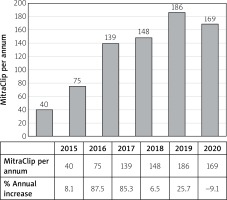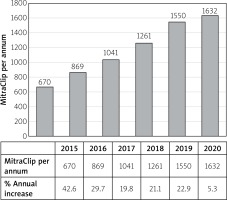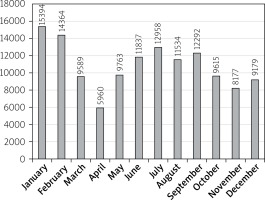As we have previously reported, the ORPKI electronic data capture is monitored continuously and modified according to the needs of the rapidly changing everyday practice of interventional cardiology not only in Poland but also worldwide as required by ESC guidelines [1, 2]. The database is endorsed by the Association of Cardiovascular Interventions of the Polish Cardiac Society (AISN PTK) and is daily operated by the Jagiellonian University Medical College, with currently 154 interventional cardiology centers in Poland reporting. ORPKI database analysis of various trends and patterns is published each year [3–5]. On 31st of December 2020 there were 575 PCI operators certified by the AISN PTK in Poland.
According to the current analysis of the ORPKI database, in comparison to 2019, there was a substantial 25% decrease in the total number of reported coronary angiographies (CAG) [1]. There were 130 662 CAG, which corresponds to 3394 per 1 million inhabitants per year in 2020 (Figure 1). The distribution of primary diagnosis as the indication for CAG was: 13% ST-elevation myocardial infarction (STEMI), 16% non-ST-elevation myocardial infarction (NSTEMI), 27% unstable angina (UA), and 45% stable angina (a 5% increase in acute coronary syndromes (ACS) preponderance that year). The radial approach was utilized in 89% of all CAG cases, which is a 1% rise in comparison to 2019 (in STEMI patients, 85% had the radial access site used). Complications of coronary angiography in 2020 were rare and corresponded to the rates reported in previous years (Table I).
Figure 1
The number of coronary angiography (A) and PCI (B) procedures in Poland in the years 2019–2020

Table I
Complications of coronary angiography in Poland in 2020
| Parameter | % | In comparison to 2019 |
|---|---|---|
| Death | 0.27% | ↑ |
| Stroke | 0.01% | ↔ |
| Major bleeding at access site | 0.04% | ↔ |
| Sudden cardiac arrest | 0.17% | ↔ |
| Allergic reaction | 0.01% | ↔ |
The total number of percutaneous coronary intervention (PCI) procedures was 82 349 and was lower by 19% (2130 PCIs per 1 million inhabitants per year) than reported to the ORPKI database in 2019 (Figure 1). The majority of the procedures were done in the setting of ACS: 42% acute myocardial infarction (21% STEMI and 21% NSTEMI), 24% unstable angina and the remaining 34% for stable angina. The number of primary PCIs per 1 million inhabitants per year is currently 440. There were 16 949 PCIs in STEMI (13% decrease) and 17 131 in NSTEMI (15% decrease). Drug-eluting stents (DES) are used in 99.8% of all cases, which corresponds to 70 597 stents. Rotablation was used in 1009 procedures (1.2% of PCIs) – a 14% decrease in comparison to 2019. Aspiration thrombectomy was used in only 1 525 STEMI (9% of all PCIs in STEMI) cases. We observed a slight increase in the use of guideline-recommended ticagrelor as an adjunct pharmacotherapy both for STEMI (55%) and NSTEMI (31%) with the use of prasugrel less than 3% in either indication. In terms of complex procedures, the number of chronic total occlusion (CTO) procedures was 1708 (26% decrease) with TIMI 3 flow after the procedure in 67% of cases. PCI complications are still rare and are presented in Table II. During the COVID-19 pandemic 0.6% of all angiographies and 0.4% of all PCIs were performed in SARS--CoV2 positive patients.
Table II
Complications of PCI in Poland in 2020
A substantial decrease in the use of adjunctive imaging and diagnostic procedures during CAG and PCI was observed in 2020 vs. 2019 (Table III).
Table III
Additional intracoronary assessment in 2020 during angiography and PCI
| Variable | N | % of all angio and PCI | Change % from 2019 |
|---|---|---|---|
| FFR | 8420 | 10 | ↓ 15 |
| IVUS | 3923 | 4.8 | ↓ 11 |
| OCT | 239 | 0.3 | ↓ 37 |
Structural procedures are a growing part of interventional cardiology in Poland and mainly performed by certified interventional cardiologists. Following recommendations of the European Society of Cardiology, 25 multidisciplinary Heart Teams involving 32 certified interventional cardiologists were established in all 25 transcatheter aortic valve implantation (TAVI) centers. There were 1647 TAVI procedures performed in 25 centers (more than 95% from femoral access). The median number of TAVI procedures per center per annum decreased to 66 in 2020 due to the opening of 3 new low volume centers. Evolut/Evolut Pro (Medtronic, USA) was implanted in 912 patients, Acurate (Boston Scientific, USA) in 258, Sapien 3/Sapien 3 Ultra/Sapien XT (Edwards Lifesciences, USA) in 243, Portico (Abbott, USA) in 122, MyValve (Merill, India) in 88, Lotus Edge (Boston Scientific, USA) in 19 patients, and Hydra (Vascular Innovations Company, Thailand) in 5.
There were 27 procedures of pulmonary valve implantation including Melody (Medtronic, USA) in 18 and Sapien 3/Sapien XT (Edwards Lifesciences, USA) in 9 patients. Two Melody valves were also implanted in the mitral position.
Only 81 TAVI procedures (4.9%) were performed using a cerebral protection system – including the commercially available Sentinel system (Boston Scientific, USA) in 73 patients and in 13 patients using ProtEmbo (Protembis, Germany) as part of a scientific study.
Although the total number of TAVI slightly increased by 107 procedures when compared to 2019 (6.5% increase year to year), Poland with the number of 43.3 TAVI procedures per million inhabitants in 2020 is far below the European average. In 2017 the annual number of TAVI procedures in Germany reached almost 20 000, with the TAVI rate of 250 per million inhabitants [6]. The data presented at the EuroPCR and ESC events in 2019 confirmed an increase of the number TAVI procedures in France from 7,500 in 2014 to 20,000 in 2018 (137%) with the TAVI penetration of 193 per million inhabitants in 2018 [7]. Then finally Portugal, often compared to Poland, recorded a significant increase of TAVI procedures during the last 5 years from 29 in 2015 to 72 in 2019 per million inhabitants [8]. It is worth mentioning that all three countries participate in the Valve-for-Life Initiative of the EAPCI ESC (Poland and France since 2015 and Portugal since 2017).
MitraClips (Abbott, USA) were implanted in 15 centers and 169 patients (decrease by 10%) mostly due to problems with reimbursement but also COVID restrictions. Moreover, it should be mentioned that Poland with about 4.4 MitraClip procedures per million inhabitants is far below the clinical needs. The dynamics of TAVI and MitraClip procedures in Poland in the last 5 years are presented in Figures 2 and 3
Only 459 left atrial appendage closure procedures were performed in 28 centers including 236 Watchman/Watchman FLX (Boston Scientific, USA), 221 Amulet (Abbott, USA) and 2 Lambre (Lifetech, China). The number of left atrial appendage (LAA) closure procedures decreased by almost 23% (year to year) mostly due to COVID restrictions.
Recent studies and changes in guidelines have established the role of patent foramen ovale (PFO) closure in routine practice as a secondary prevention in patients after embolic stroke of unknown source not only among cardiologists but also neurologists – 710 PFO closure procedures were performed last year. Additionally, 435 secundum atrial septal defect (ASD II) closure procedures were performed in 2020 by interventional cardiologists.
The ORPKI database was the source material for 20 manuscripts published in PubMed in 2019–2020. The AISN PTK issued 1 statement and expert opinion. The scientific activity was enriched by 8 conferences with AISN PTK endorsement and 5 webinars. There were altogether 1 prize and 2 grants on behalf of the AISN PTK in 2020. Many leading Polish cardiologists are active members of EAPCI ESC committees during the 2020–2022 term of Professor Dariusz Dudek as President. There are 14 Polish members of committees with 5 of them serving as Chairs and Co-Chairs (Maciej Lesiak, Wojciech Wojakowski, Marek Grygier, Radosław Parma, Paweł Gąsior).
In conclusion, the COVID-19 pandemic has had an immense impact on interventional cardiology in Poland. We have observed a substantial decrease in the number of CAG and PCIs across various indications as well as underutilization of modern imaging and physiologic assessment techniques. Even though the absolute numbers represent only participating centers, the relative decrease is widely seen also in data provided by the national health insurance provider (NFZ). On the other hand, the use of a radial approach and ticagrelor in MI patients is well in line with ESC recommendations. It seems that the first wave lockdown had the most devastating impact (March–April 2020) on the overall numbers for 2020 [9] (Figure 4). The number of the majority of structural procedures showed a significant decrease last year, partially because of COVID restrictions (LAA closure, ASD, PFO, MitraClip), limited referrals and even closure of some interventional cardiology sites for non-COVID patients but mostly due to very limited reimbursement (MitraClip). Although the number of TAVI procedures in 2020 increased slightly even despite COVID restrictions (in some centers due to those restrictions and moving patients from classical aortic valve replacement to less invasive TAVI requiring less hospital resources), one should remember that numbers of TAVI and especially MitraClip procedures are far below the European average and current clinical needs in Poland.











